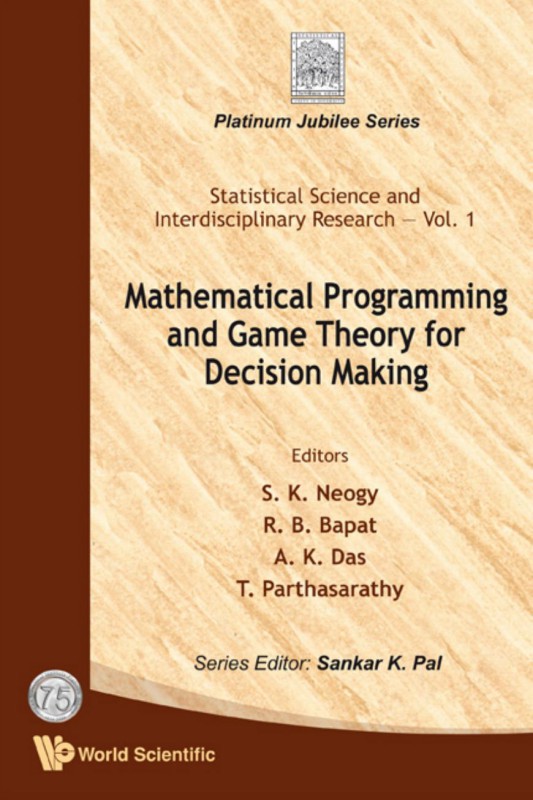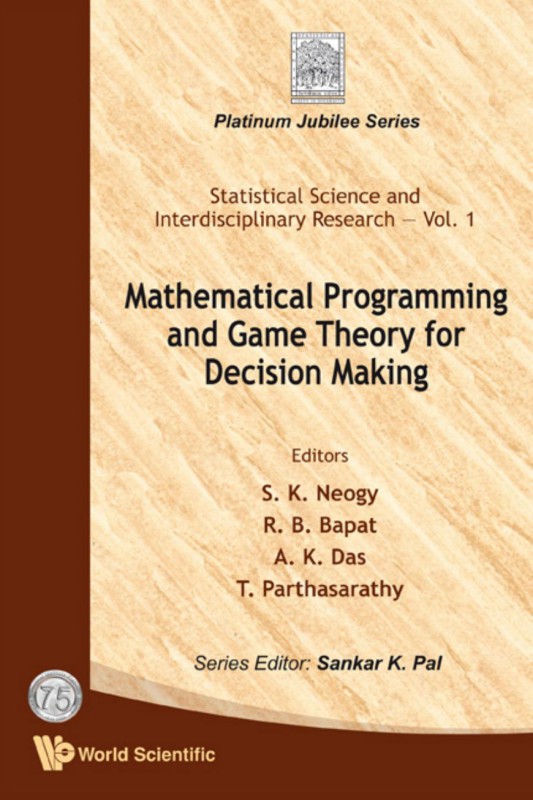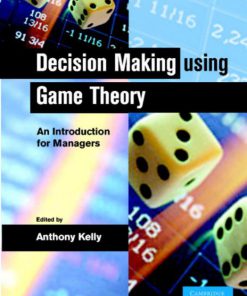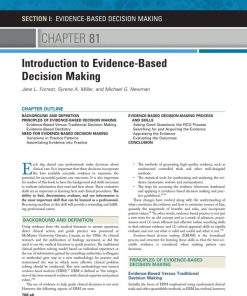Mathematical Programming and Game Theory for Decision Making Volume 1 1st Edition by SK Neogy, RB Bapat, AK Das, Parthasarathy, Sankar Pal ISBN 9789812813220 9812813225
$50.00 Original price was: $50.00.$25.00Current price is: $25.00.
Authors:S. K. Neogy, R. B. Bapat, A. K. Das; T. Parthasarathy , Series:Gaming [82] , Author sort:S. K. Neogy, R. B. Bapat, A. K. Das & Parthasarathy, T. , Languages:Languages:eng , Published:Published:Jun 2008 , Publisher:World Scientific
Mathematical Programming and Game Theory for Decision Making Volume 1 1st Edition by SK Neogy, RB Bapat, AK Das, Parthasarathy, Sankar Pal – Ebook PDF Instant Download/Delivery. 9789812813220 ,9812813225
Full download Mathematical Programming and Game Theory for Decision Making Volume 1 1st Edition after payment

Product details:
ISBN 10: 9812813225
ISBN 13: 9789812813220
Author: SK Neogy, RB Bapat, AK Das, Parthasarathy, Sankar Pal
Mathematical Programming and Game Theory for Decision Making Volume 1 1st Edition Table of contents:
1. Mathematical Programming and its Applications in Finance L. C. Thomas
Abstract
1.1 Introduction
1.2 Portfolio Optimization
1.3 Asset-liability Models
1.4 Yield Curves
1.5 Credit Scorecards
Bibliography
2. Anti-stalling Pivot Rule for Linear Programs with Totally Unimodular Coe cient Matrix S. N. Kabad
Abstract
2.1 Introduction
2.2 Pivot Selection Rule
Bibliography
3. A New Practically E cient Interior Point Method for Convex Quadratic Programming K. G. Murty
Abstract
3.1 Introduction
3.2 The Centering Strategy
3.3 Descent Step Using a Descent Direction
3.4 Descent Step Using the Touching Constraints
3.5 The Algorithm
3.6 Convergence Results
3.7 The Case When the Matrix D is Not Positive Definite
Bibliography
4. A General Framework for the Analysis of Sets of Constraints R. Caron and T. Traynor
Abstract
4.1 Introduction
4.2 The Set Covering Formulation
4.3 Random Sampling
Acknowledgement
Bibliography
5. Tolerance-based Algorithms for the Traveling Salesman Problem D. Ghosh, B. Goldengorin, G. Gutin
Abstract
5.1 Introduction
5.2 Some Relevant Concepts
5.2.1 The Relaxed Assignment Problem
5.2.2 Determining Tolerances for AP and RAP
5.2.3 The Contraction Procedure and a Greedy Algorithm
5.3 Tolerance-based Greedy Algorithms
5.4 Computational Experience
5.5 Summary and Future Research Directions
Bibliography
6. On the Membership Problem of the Pedigree Polytope T. S. Arthanari
Abstract
6.1 Introduction
6.1.1 Computational Complexity, Polytopes and Efficiency
6.2 Preliminaries & Notations
6.2.1 Rigid, Dummy arcs in a Capacited Transportation Problem
6.2.2 Definition of the Pedigree Polytope
6.2.3 Multistage Insertion and Related Results
6.3 Polytopes and Efficiency
6.3.0.1 Problems Related to Polytopes
6.3.1 Properties of the Polytope, conv(An)
6.4 Construction of the Layered Network N
6.5 Necessity of Fk Feasibility for Membership
6.6 Pedigree Packability
6.7 A Multicommodity Flow Problem to Check Member- ship
6.8 Computational Complexity of Checking the Necessary Condition
6.9 Concluding Remarks
Acknowledgements
Bibliography
7. Exact Algorithms for a One-defective Vertex Colouring Problem N. Achuthan, N. R. Achuthan and R.
Abstract
7.1 Introduction
7.2 Sequential Colouring Heuristics for k-DVCP
7.3 Implicit Enumeration Algorithms for 1–DVCP
7.4 Computational Performance of the Algorithms
Acknowledgement
Bibliography
8. Complementarity Problem involving a Vertical Block Matrix and its Solution using Neural Network M
Abstract
8.1 Introduction
8.2 Preliminaries
8.3 Main Results
8.4 Computing VLCP Solution Using the Neural Network Dynamics
8.4.1 Proposed Neural Network Dynamics
8.5 Simulation Results
Bibliography
9. Fuzzy Twin Support Vector Machines for Pattern Classi cation R. Khemchandani, Jayadeva and S. Cha
Abstract
9.1 Introduction
9.2 Support Vector Machines
9.3 Twin Support Vector Machines
9.4 Fuzzy Twin Support Vector Machines
9.5 Experimental Results
9.6 Concluding Remarks
Acknowledgements
Bibliography
10. An Overview of the Minimum Sum of Absolute Errors Regression S. C. Narula and J. F. Wellington
Abstract
10.1 Introduction
10.2 Computational Algorithms
10.3 Statistical Properties and Inference
10.4 Variable Selection
10.5 Coefficient of Determination
10.6 Other Results
10.7 Likelihood Displacement
10.8 Robustness
10.9 Multiple Criteria Linear Regression Using MSAE
10.10 Concluding Remarks
Bibliography
11. Hedging against the Market with No Short Selling S. A. Clark and C. Srinivasan
Abstract
11.1 Introduction
11.2 Securities Market Model
11.3 Fundamental Value
11.4 Trading Strategies
11.5 Hedging Prices
Bibliography
12. Mathematical Programming and Electrical Network Analysis II: Computational Linear Algebra throug
Abstract
12.1 Introduction
12.2 Electrical Network Analysis Procedures
12.2.1 Nodal Analysis
12.2.2 Loop Analysis
12.2.3 Hybrid Analysis
12.3 Experimental Results
12.4 A Proposal
12.5 Conclusion
Appendix: A variation of PCG
A.1 Modi ed CG
A.2 Modi ed Preconditioned CG
A.3 Justi cation for Modi ed Preconditioned CG
Bibliography
13. Dynamic Optimal Control Policy in Price and Quality for High Technology Product A. K. Bardhan an
Abstract
13.1 Introduction
13.2 Dynamic Diffusion of Demand
13.3 Model Development
13.4 Dynamic Optimization
13.5 Theoretical Results
13.6 Pricing and Quality Impact on Leapfrogging
13.7 Optimal Introduction Timing Strategy for Second Generation Product
13.8 Conclusions
Acknowledgement
Appendix
A. Optimal Pricing
B. Significance of Pricing and Quality in Leapfrogging
C. Optimal Introduction Timing Strategy
Bibliography
14. Forecasting for Supply Chain and Portfolio Management K. G. Murty
Abstract
14.1 Introduction
14.2 Costs of High Inventories and Shortages
14.3 Commonly used Techniques for Forecasting Demand
14.4 Parametric Methods for Forecasting Demand Distri- bution
14.4.1 Using Normal Distribution with updating of Ex- pected Value and Standard Deviation in each Pe
14.4.2 Using Normal Distribution with Updating of Ex- pected Value and Standard Deviation only when
14.4.3 Using Distributions other than Normal
14.5 A Nonparametric Method for Updating and Forecast- ing the Entire Demand Distribution
14.6 An Application of the Forecasting Method of Section 14.5 for computing Optimal Order Quantities
14.7 How to incorporate Seasonality in Demand into the Model
14.8 Portfolio Management
14.9 Variance as a Measure of Risk, and the Markovitz Model for Portfolio Optimization
14.10 Other Measures of Risk for Portfolio Optimization
14.11 Portfolio Management: Tracking the Distribution of Return from a Portfolio that is kept for a
14.12 A Model based on Statistical Learning to nd an Op- timum Portfolio
Bibliography
15. Variational Analysis in Bilevel Programming S. Dempe, J. Dutta and B. S. Mordukhovich
Abstract
15.1 Introduction
15.2 Tools from Variational Analysis
15.3 Partially Convex Lower-level Problems
15.4 Fully Convex Lower-level Problems
Acknowledgements
16. Game Engineering R. J. Aumann
Auctions:
Bibliography
Arbitration:
Traffic:
17. Games of Connectivity P. Dubey and R. Garg
Abstract
17.1 Introduction
17.2 Examples
17.2.1 Multicast Transmission
17.2.2 Unicast Transmission
17.2.3 Transmission of Layered Information
17.2.4 Transmission of Information Partitions
17.2.5 General Network with Controlled Edges
17.3 The Abstract Model
17.3.1 The Communications Network
17.3.2 Information
17.3.3 Location of Players and Public Facilities
17.3.4 Control of Edges
17.3.5 The Transmission of Information
17.3.6 The Reception of Information
17.3.7 The Cost of a Transmission
17.3.8 The Bene t from a Transmission
17.4 The Connectivity Game
17.5 The Growing Transmissions Property
17.6 Remarks
17.7 Appendix
17.7.1 Proof of Theorem 17.1
17.7.2 Proof of Theorem 17.2
Bibliography
18. A Robust Feedback Nash Equilibrium in a Climate Change Policy Game M. Hennlock
Abstract
18.1 Introduction
18.2 The Climate Models
18.2.1 Climate Change Impacts
18.3 Players and Payo s
18.3.1 Investor i 2 [1; n]
18.3.2 Policy Maker j 2 [1;N]
18.3.3 Game Formulations
18.4 Concluding Comments
18.5 Summary
18.6 Appendix
18.6.1 Appendix A.1 Proof of Proposition 1
18.6.2 Appendix A.2 Proof of Proposition 2
Bibliography
19. De Facto Delegation and Proposer Rules H. Imai and K. Yonezaki
Abstract
19.1 Introduction
19.2 Model and Result
19.3 Proof
19.4 FO rule and Discussion
19.5 Conclusion
Acknowledgements
Bibliography
20. The Bargaining Set in E ectivity Function D. Raza mahatolotra
20.1 Introduction
20.2 Definitions and Notations
20.3 Some Analysis of Cycles
20.4 Stability and Cycles
20.4.1 Comparison of the Bargaining Sets
20.4.2 The Zhou’s Bargaining Set
20.4.3 The Mass-Colell’s Bargaining Set
20.5 Annexe
Bibliography
21. Dynamic Oligopoly as a Mixed Large Game { Toy Market A. Wiszniewska-Matyszkiel
Abstract
21.1 Introduction
21.1.1 Large Games
21.2 Formulation of the Basic Model
21.2.1 Producers
21.2.2 Parents (and Children)
21.2.3 Market Clearing
21.3 Results
21.3.1 Case A: Two Periods with Dead-Season
21.3.2 Case B: Two Periods
21.3.3 Case C: Finitely Many Stages and Negligibility of Low Advertising Efforts
21.3.4 Case D: In nite Time Horizon and Negligibility of Low Advertising Efforts
21.4 Conclusions
Bibliography
22. On Some Classes of Balanced Games R. B. Bapat
Abstract
22.1 Introduction
22.2 Regression Games
22.3 Connectivity Games
Bibliography
23. Market Equilibrium for Combinatorial Auctions and the Matching Core of Nonnegative TU Games S. L
Abstract
23.1 Introduction
23.2 Combinatorial Auctions
23.3 Games with Transferable Utilities
23.4 Games with Transferable Utilities as Combinatorial Auctions
23.5 Market Equilibrium and Matching Cores
23.6 Discussion
Acknowledgements
Bibliography
24. Continuity, Manifolds, and Arrow’s Social Choice Problem K. Saukkonen
Abstract
24.1 Introduction
24.2 Continuity via Topological Manifolds
24.2.1 Background
24.2.2 Chickhilnisky’s Smooth Social Welfare Function
24.2.3 Illustrations of the Framework
24.2.4 Implications of the Manifold View
24.3 Manifolds and Arrovian Social Choice Systems
24.3.1 Simple Arrow-type Social Choice System
24.3.2 Market Mechanism and Welfare
24.3.3 Voting
24.3.4 Legislation
24.3.5 Arrow’s Abstract Theory of Collective Decision Making
24.4 Summary
Bibliography
25. On a Mixture Class of Stochastic Game with Ordered Field Property S. K. Neogy, A. K. Das, S. Sin
Abstract
25.1 Introduction
25.2 Preliminaries
25.3 Discounted Zero-sum SC/AR-AT Mixture Stochastic Game
25.4 Undiscounted Zero-sum SC/AR-AT Mixture Stochas- tic Game
25.5 Computation of Value Vector and Optimal Stationary Strategies for SC/AR-AT Mixture Class of Sto
Bibliography
People also search for Mathematical Programming and Game Theory for Decision Making Volume 1 1st Edition:
mathematical introduction to linear programming and game theory
what is game theory in mathematics
game programming math
mathematics for game programming and computer graphics
You may also like…
eBook ZIP
The Art of Computer Programming Volume 1 1st edition by Donald Knuth 0321657314 9780321657312












